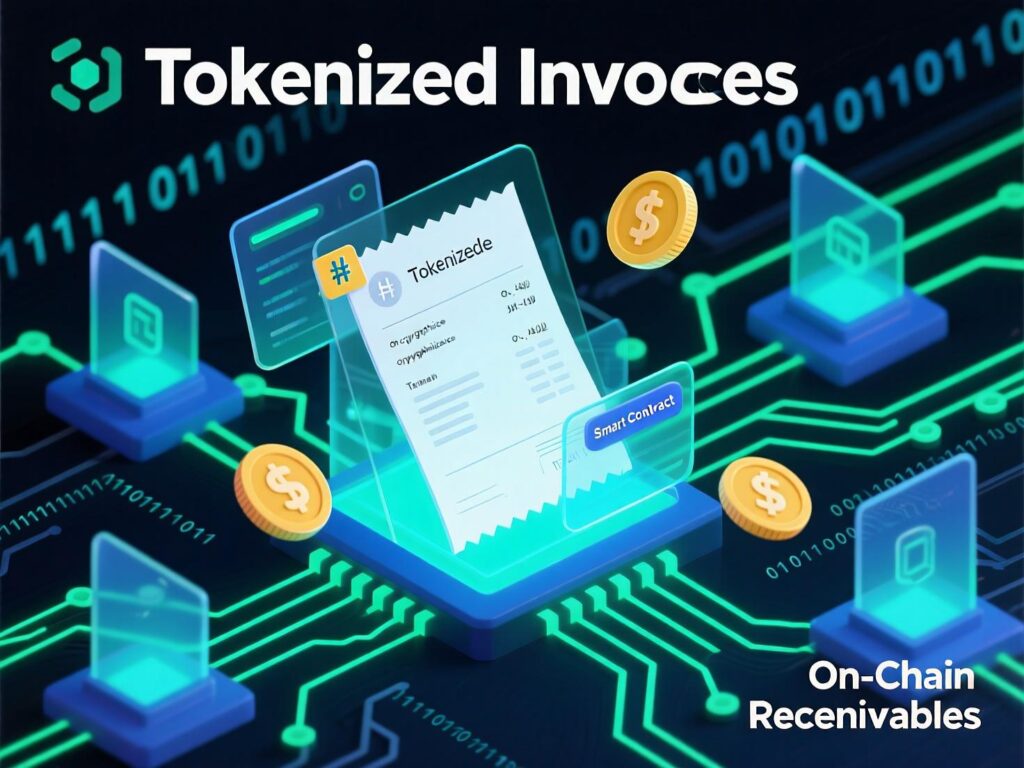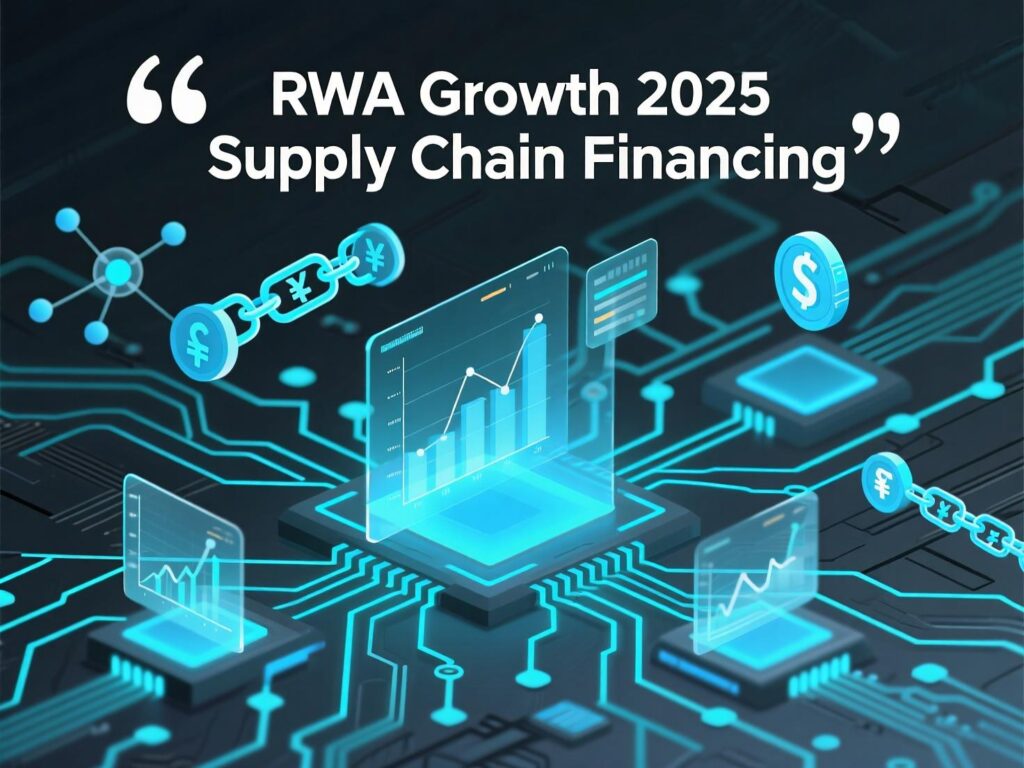Crypto-Powered Supply Chain Financing
Supply chains run on cash flow, not just containers. Yet even healthy suppliers wait 45–120 days for payment, tying up capital and stalling growth. Crypto-powered supply chain financing turns purchase orders, invoices, and receivables into tokenized, financeable assets that settle in minutes and interoperate across DeFi rails.
By combining real-world asset (RWA) tokenization with stablecoins and smart contracts, companies can access new liquidity sources, automate covenants, and gain auditable, real-time visibility on collateral. Platforms like Centrifuge, Polytrade, Maple and Goldfinch now connect institutional capital and crypto liquidity to real-world credit, with sector inflows accelerating through 2024–2025. Crypto-powered supply chain financing isn’t a future concept; it’s quietly funding receivables and private credit today, with measurable cost and time benefits reported by leading RWA players.
What is Crypto-Powered Supply Chain Financing? (SCF, DeFi & RWAs)
At its core, crypto-powered supply chain financing applies tokenization to supply-chain assets (purchase orders, invoices, inventory, warehouse receipts) and uses them as on-chain collateral for funding. Tokens reference legally structured claims (via SPVs, trusts, or fund vehicles), while stablecoins (e.g., USDC/DAI) enable near-instant settlement. Issuers manage pools; investors subscribe to tokenized notes or pool shares; lenders extend credit programmatically against transparent asset data. Leaders such as Centrifuge report $646M+ total assets financed and 1,500+ tokenized assets as of August 2025—evidence of growing real-world activity on chain.
Why Now? Market Momentum and Liquidity Shift
RWA growth: Tokenized real-world assets expanded from ~$5B in 2022 to $24B+ by June 2025, making RWAs the second fastest-growing crypto sector after stablecoins. This influx improves depth and pricing for crypto-powered supply chain financing pools.
On-chain private credit: Maple Finance reports multi-billion tokenized private credit origination and rapid TVL growth into 2025, as institutional partners adopt on-chain rails broadening the lender base for receivables and working-capital programs.
Operational efficiency: Case studies show dramatic securitization cost savings using automated smart contracts BlockTower/Centrifuge reported 97% lower costs running on-chain credit structures. While not specific solely to SCF, these efficiencies apply directly to receivables pools.
How It Works (Step-By-Step)
Digitize & verify assets:
Standardize POs/invoices; attach KYC/KYB, UBL/UBL-JSON e-invoices, and trade docs.
Tokenize receivables:
Issue asset tokens (NFTs/partitioned ERCs) representing legal claims to cash flows.
Pool & structure:
Place assets into an SPV-backed pool (senior/junior tranches).
Fund with crypto liquidity:
Investors and lenders subscribe in stablecoins; smart contracts enforce advance rates, eligibility, and waterfalls.
Monitor & service:
Oracles and servicers update on-chain performance; breaches auto-trigger cures.
Redeem & settle:
Upon debtor payment, cash flows return to the pool; investors are redeemed on-chain.
This crypto-powered supply chain financing loop compresses days of manual ops into automated flows with auditable trails.

Real-World Case Studies (Concise)
Case Study 1 — Centrifuge x BlockTower (Structured Credit → Playbook for SCF)
BlockTower used Centrifuge to run tokenized CLO-style pools, reporting 97% cost savings and a successful investor return. While focused on private credit, the same technology stack (asset-level NFTs, automated waterfalls) underpins invoice pools in crypto-powered supply chain financing.
Case Study 2 — Polytrade (Invoice Financing via DeFi Liquidity)
Polytrade pioneered using crypto liquidity to finance real-world invoices, with early transactions executed in 2022 and continued build-out through 2024–2025 on Polygon expanding a marketplace for tokenized trade finance. For SMEs, this reduces approval times and broadens lender reach—core value props of crypto-powered supply chain financing.
Case Study 3 Goldfinch (Off-Chain Borrowers, On-Chain Capital)
Goldfinch channels stablecoin liquidity to real-world lenders in emerging markets and launched Goldfinch Prime in 2025 to aggregate exposure to large private-credit funds—another pathway for diversified, on-chain credit that can back receivable-based programs. Goldfinch PrimeMessari
Benefits vs. Traditional SCF
Speed & working-capital impact: On-chain settlement cuts time-to-cash versus bank cycles; transparency eases audits and covenant checks. Crypto-powered supply chain financing reduces reconciliation errors through a single shared ledger.
Cost & scalability: Automated trustee/calculation functions and programmatic waterfalls lower overhead; Centrifuge’s data points indicate the magnitude of potential savings when replacing intermediaries.
Access to diversified capital: Maple/Goldfinch/Centrifuge broaden lender profiles beyond a single bank, making crypto-powered supply chain financing more resilient to credit cycles.
Risks & How to Mitigate Them
Legal enforceability: Use SPVs with perfected security interests and jurisdiction-appropriate documentation; align token rights with off-chain claims.
Data integrity & fraud: Tie tokens to verifiable e-invoice rails and trade docs; leverage third-party verification and oracles; maintain servicer oversight.
Liquidity & market risk: Size advance rates conservatively; include over-collateralization and dynamic eligibility criteria.
Regulatory/KYC/AML: Embed KYC/KYB at investor onboarding, including sanctions screening.
Counterparty performance: Diversify obligors; monitor concentration limits.
These controls are core to credible crypto-powered supply chain financing programs.

Tooling & Platform Landscape
Issuance & tokenization: Centrifuge for asset-level NFTs, RWA launchpads, and on-chain fund tooling (>$646M assets financed as of Aug 2025). e
Invoice finance & marketplaces: Polytrade (DeFi-funded receivables).
On-chain private credit: Maple (institutional pools, fast-growing TVL); Goldfinch (emerging-market lenders; Prime pool for institutional credit exposure). Enterprise trade-finance rails (context): Komgo and Contour digitalize LCs/guarantees and trade docs—useful bridges for corporates integrating crypto-powered supply chain financing with existing workflows.
Implementation Playbook: Launch a 90-Day Pilot (How-To)
Define scope & KPIs:
Choose one supplier cohort and invoice type; set KPIs for DSO reduction, financing cost, and default rates.
Legal structuring:
Form an SPV; finalize receivables purchase agreement and token terms; align with auditor.
Data pipeline:
Integrate ERP/e-invoicing; map invoice metadata to token schema.
Platform selection:
Evaluate Centrifuge (issuance/pooling), Polytrade (marketplace), Maple/Goldfinch (credit).
On-chain setup:
Deploy pool smart contracts; set advance rates, eligibility rules, waterfalls.
Investor onboarding:
KYC/AML; whitelist wallets; structure junior/senior tranches.
Go-live & monitor:
Finance first batch; track SLA, exceptions, and cash-flow timings.
Iterate & scale:
Expand obligor set; automate reporting to finance leadership.
This practical crypto-powered supply chain financing pilot shows value quickly while managing risk.
Compliance & E-Invoicing
Global e-invoicing mandates (e.g., France and other markets) push standardized, machine-readable invoices—prime inputs for tokenization and automated verification. Aligning your program with e-invoicing rails reduces fraud and onboarding friction in crypto-powered supply chain financing.
Localization Buckets (Global GEO Options)
US: “Crypto-Powered Supply Chain Financing for CFOs: Unlock Liquidity with Stablecoins” geo keywords: supply chain finance US, on-chain receivables USA, tokenized invoices US.
UK: “Crypto-Powered Supply Chain Financing in the UK: Faster Settlements & Real-Time Controls” — geo keywords: UK trade finance blockchain, on-chain SCF UK, tokenized receivables UK.
India: “Crypto-Powered Supply Chain Financing for Indian Exporters: From GST E-Invoices to On-Chain Liquidity” geo keywords: India e-invoice tokenization, MSME invoice finance crypto, RWA trade finance India.

Final Words
Supply-chain leaders no longer need to accept slow cash cycles as a given. By tokenizing receivables and connecting to diversified on-chain lenders, crypto-powered supply chain financing compresses time-to-cash, lowers operational friction, and scales beyond the limits of single-bank programs.
With RWAs surpassing $24B by mid-2025 and issuance platforms reporting hundreds of millions financed, the infrastructure is mature enough for prudent pilots especially when paired with strong legal structuring and compliance. Start small, measure rigorously, and expand as data supports. The result: resilient liquidity, transparent risk, and a finance stack built for always-on global trade. Crypto-powered supply chain financing is the shortest path between shipped goods and cash in the bank.
CTA: Ready to scope a 90-day pilot? Contact our team for a curated vendor shortlist, template documents, and KPI dashboards tailored to your ERP and supplier mix.
FAQs
1) How does crypto-powered supply chain financing differ from traditional SCF?
A : It tokenizes receivables into on-chain assets and funds them with stablecoin liquidity via smart contracts, reducing intermediaries and adding real-time transparency. This can speed settlement and lower operational costs versus bank-only programs.
2) How do we ensure legal enforceability of tokenized invoices?
A : Use SPVs and jurisdiction-specific documentation that tie token rights to off-chain claims, with perfected security interests. Many platforms provide standardized legal templates and servicer roles to maintain enforceability.
3) How can SMEs access crypto-powered supply chain financing?
A : Marketplaces like Polytrade connect SMEs to on-chain liquidity for invoice financing; lenders underwrite cash-flow data and debtor quality rather than only hard collateral.
4) How is risk managed in on-chain receivables pools?
A : Via advance-rate limits, concentration caps, eligibility criteria, over-collateralization, and automated waterfalls; servicers monitor delinquencies with real-time data.
5) How does this integrate with e-invoicing mandates?
A : Standardized e-invoices (e.g., France’s mandate) feed structured data to tokenization, improving verification and fraud checks—ideal inputs for crypto-powered supply chain financing.
6) How can we attract institutional investors?
A : Offer transparent, auditable on-chain data, robust legal structures, reputable servicers, and senior/junior tranching. Institutional adoption is rising across RWA/private credit platforms.
7) How do stablecoins fit into the flow?
A : They enable 24/7 settlement and programmable distributions. Many programs settle in USDC/DAI, simplifying cross-border flows.
8) How fast can a pilot launch?
A : Typical 60–90 days if legal docs, ERP integrations, and KYC/AML workflows are prepared. Start with one supplier cohort and expand.
9) How does this reduce costs?
A : Automation replaces trustee, calculation, and reconciliation layers. Case studies show large savings in on-chain credit ops that translate to receivables programs.



